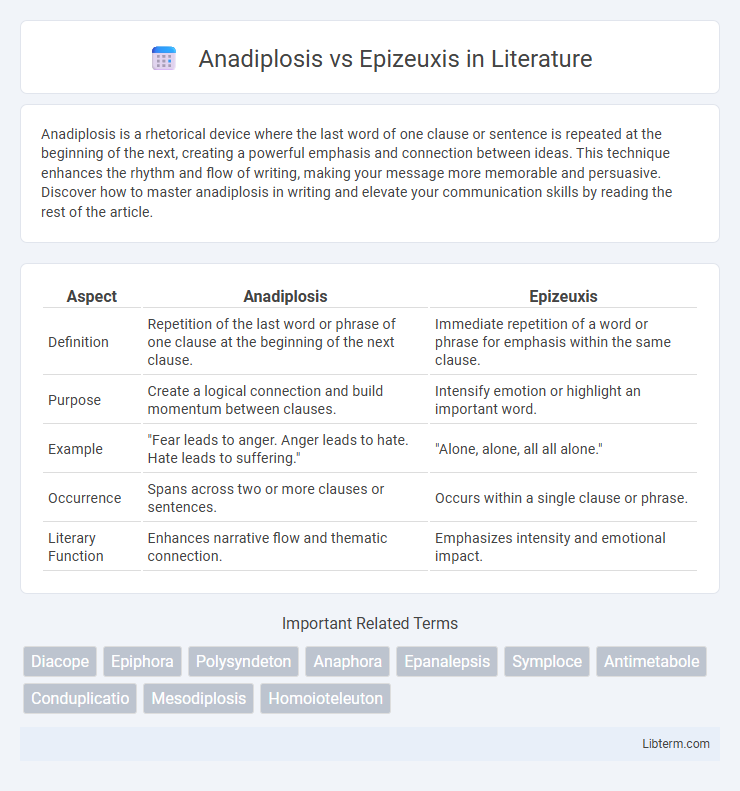Anadiplosis is a rhetorical device where the last word of one clause or sentence is repeated at the beginning of the next, creating a powerful emphasis and connection between ideas. This technique enhances the rhythm and flow of writing, making your message more memorable and persuasive. Discover how to master anadiplosis in writing and elevate your communication skills by reading the rest of the article.
Table of Comparison
| Aspect | Anadiplosis | Epizeuxis |
|---|---|---|
| Definition | Repetition of the last word or phrase of one clause at the beginning of the next clause. | Immediate repetition of a word or phrase for emphasis within the same clause. |
| Purpose | Create a logical connection and build momentum between clauses. | Intensify emotion or highlight an important word. |
| Example | "Fear leads to anger. Anger leads to hate. Hate leads to suffering." | "Alone, alone, all all alone." |
| Occurrence | Spans across two or more clauses or sentences. | Occurs within a single clause or phrase. |
| Literary Function | Enhances narrative flow and thematic connection. | Emphasizes intensity and emotional impact. |
Introduction to Anadiplosis and Epizeuxis
Anadiplosis is a rhetorical device characterized by the repetition of the last word or phrase of one clause at the beginning of the next, creating a chain-like effect that enhances emphasis and continuity. Epizeuxis involves the immediate repetition of a word or phrase within a sentence to intensify emotion or highlight importance. Both figures of speech are frequently utilized in literature and speeches to add rhythm, reinforce ideas, and engage the audience through strategic repetition.
Understanding Anadiplosis: Definition and Purpose
Anadiplosis is a rhetorical device where the last word or phrase of one sentence or clause is repeated at the beginning of the next, creating a chain-like emphasis that enhances the flow and reinforces key concepts. Its primary purpose is to build intensity and focus the audience's attention on significant ideas, making arguments more memorable and persuasive. Prominent examples, such as "Fear leads to anger; anger leads to hate; hate leads to suffering" from Star Wars, illustrate how anadiplosis effectively underscores cause-and-effect relationships.
Exploring Epizeuxis: Meaning and Function
Epizeuxis is a rhetorical device characterized by the immediate repetition of a word or phrase to emphasize emotion or intensity, often found in poetry and speeches. This technique functions to heighten the impact of an idea by reinforcing its significance through continuous repetition, creating a memorable and rhythmic effect. Unlike anadiplosis, which repeats the last word of one clause at the beginning of the next, epizeuxis repeats words consecutively within the same clause for dramatic emphasis.
Structural Differences Between Anadiplosis and Epizeuxis
Anadiplosis features the repetition of the last word or phrase of one clause at the beginning of the next, creating a chain-like structure that emphasizes continuity and progression. Epizeuxis involves immediate repetition of a word or phrase within the same clause, intensifying emotion or emphasis through rapid reiteration. The key structural difference lies in Anadiplosis' linking across clauses versus Epizeuxis' tight, repeated emphasis within a single clause.
Effects on Tone and Rhythm in Writing
Anadiplosis enhances tone and rhythm by creating a seamless flow through the repetition of the last word of one clause at the beginning of the next, which intensifies emphasis and builds a sense of progression or inevitability. Epizeuxis sharpens tone and accelerates rhythm by repeating a word or phrase immediately, generating urgency, intensity, or emotional impact. Both devices manipulate repetition strategically; anadiplosis fosters connectivity and momentum, while epizeuxis injects forcefulness and heightened dramatic effect into the prose or poetry.
Notable Examples in Literature and Speech
Anadiplosis appears in Shakespeare's *Macbeth* with the line "Fear leads to anger. Anger leads to hate. Hate leads to suffering," showcasing repeated word linkage for dramatic effect. Epizeuxis is famously used in Martin Luther King Jr.'s speech with the phrase "I have a dream, I have a dream," emphasizing key ideas through immediate repetition. Both rhetorical devices enhance persuasion and memorability by strategically repeating words, either at the sentence end and start (anadiplosis) or consecutively (epizeuxis).
How Anadiplosis Enhances Cohesion
Anadiplosis enhances cohesion by repeating the last word or phrase of a sentence at the beginning of the next, creating a seamless link between ideas that strengthens flow and emphasis. This technique fosters a rhythmic progression, guiding the reader through a chain of connected thoughts or concepts in a harmonious manner. In contrast, epizeuxis relies on rapid repetition within a single phrase to intensify emotion or urgency, but does not inherently build narrative or thematic connection like anadiplosis.
The Impact of Epizeuxis on Emphasis
Epizeuxis, the repetition of a word or phrase in immediate succession, dramatically heightens emphasis and intensifies the emotional impact of a statement. Unlike anadiplosis, which links phrases by repeating the last word of one clause at the beginning of the next, epizeuxis creates a powerful, rhythmic effect that captures attention and reinforces key ideas. This linguistic device is frequently used in rhetoric, poetry, and speeches to create urgency and underscore important themes.
Choosing the Right Device for Your Message
Choosing between anadiplosis and epizeuxis depends on the desired emphasis and rhythmic effect in your message. Anadiplosis, the repetition of the last word of a clause at the beginning of the next, effectively builds a chain of ideas, enhancing logical flow and emotional impact. Epizeuxis, the immediate repetition of a word or phrase, intensifies emotion or urgency, making it ideal for dramatic or persuasive contexts.
Summary: Anadiplosis vs Epizeuxis in Rhetorical Writing
Anadiplosis is a rhetorical device where the last word or phrase of a sentence or clause is repeated at the beginning of the next, creating a seamless connection that emphasizes a key concept. Epizeuxis involves the immediate repetition of a word or phrase within the same sentence, intensifying expression and emotional impact. Both techniques enhance rhetorical writing by reinforcing ideas, but Anadiplosis links clauses for continuity while Epizeuxis amplifies emphasis through rapid repetition.
Anadiplosis Infographic

 libterm.com
libterm.com